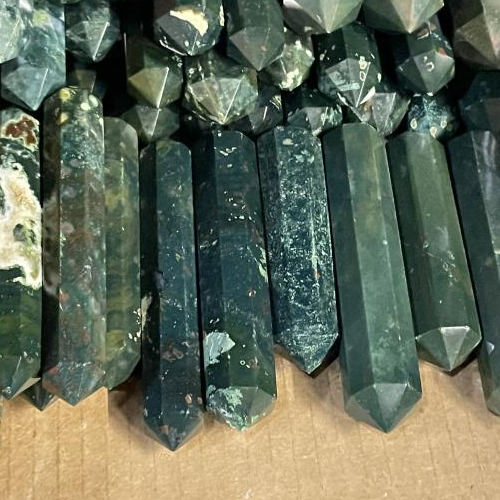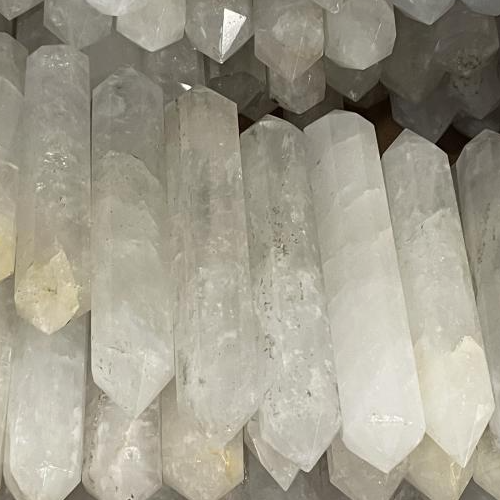Product Description
Sodalite Point Double Terminated 3"-4.5"
Mineral Information:
Sodalite is a beautiful blue mineral that is often used as a gemstone and in various ornamental applications. It is a member of the feldspathoid mineral group and belongs to the larger group of minerals known as tectosilicates. Sodalite is primarily composed of sodium aluminum silicate chloride (Na₈Al₆Si₆O₂₄Cl₂) and is recognized for its vibrant blue color with white veins or patches.
Here are some key characteristics and information about sodalite:
-
Appearance: Sodalite typically has a rich, deep blue color, often with white or grayish veins running through it. Its coloration can vary from light to dark blue, and some sodalite specimens may also contain additional colors like yellow, green, or red as a result of impurities. Sodalite is typically opaque, although some translucent varieties can be found.
-
Hardness and Composition: Sodalite has a hardness of 5.5 to 6 on the Mohs scale, making it relatively durable and suitable for jewelry and decorative purposes. Its chemical composition consists of sodium (Na), aluminum (Al), silicon (Si), oxygen (O), and chlorine (Cl).
-
Occurrence: Sodalite is found in various locations worldwide, including Canada, Brazil, Russia, Greenland, Namibia, and the United States. It commonly occurs in igneous rocks such as syenite, nepheline syenite, and phonolite. Sodalite is often associated with other minerals such as feldspar, nepheline, and calcite.
-
Uses: Sodalite is highly valued as a gemstone and is used in various jewelry pieces, including beads, pendants, and cabochons. Its vibrant blue color and attractive patterns make it sought after by collectors and jewelry enthusiasts. Sodalite is also used for decorative purposes, such as in sculptures, carvings, and ornamental objects.
Other major varieties:
Hackmanite Tenebrescent; violet-red or green fading to white
Metaphysical Meaning:
Sodalite is associated with enhancing communication and expression, stimulating mental clarity, and promoting intuition. Sodalite is also thought to encourage rational thinking, self-discipline, and emotional balance.
Mineral Care:
Sodalite is considered to have moderate to good durability, but it is not as hard as some other gemstones. Its fragility is influenced by several factors:
-
Hardness: Sodalite has a hardness of 5.5 to 6 on the Mohs scale. While this is relatively durable, it is still susceptible to scratches and abrasions. Harder materials, such as those with a higher Mohs hardness, can potentially scratch or damage sodalite if they come into contact with it. Therefore, it is important to handle sodalite with care and avoid contact with harder substances.
-
Cleavage: Sodalite exhibits poor to indistinct cleavage in three directions. Cleavage refers to the tendency of a mineral to break along specific planes or directions. Although sodalite's cleavage is not highly pronounced, it can still influence its fragility. If sodalite is subjected to strong impacts or pressure, it can break along these cleavage planes, resulting in fractures or the separation of crystal layers.
-
Structure: Sodalite has a complex crystal structure with interconnected networks of atoms. This intricate structure can contribute to its fragility, as disruptions or disturbances to the crystal lattice can weaken the overall integrity of the mineral. Consequently, sodalite may be more vulnerable to breaking or chipping if it experiences rough handling or significant mechanical stress.
To protect sodalite and minimize the risk of damage, consider the following precautions:
- Avoid exposing sodalite to rough or abrasive surfaces that can scratch or abrade the stone.
- Store sodalite separately from other gemstones or hard materials to prevent potential damage caused by contact or friction.
- Handle sodalite gently and with care to prevent accidental impacts or dropping.
- When cleaning sodalite, use mild soap and lukewarm water, and avoid harsh chemicals or ultrasonic cleaners that can potentially damage the stone.
- Consider setting sodalite in protective jewelry settings that offer stability and support, reducing the risk of accidental damage to the stone.
By taking these precautions and handling sodalite with care, you can help preserve its beauty and integrity, reducing the likelihood of fragility-related issues.
Disclaimer:
No information here is intended to diagnose, treat or cure ailments or afflictions of any kind. One should always consult a medical professional if a serious issue presents itself.






